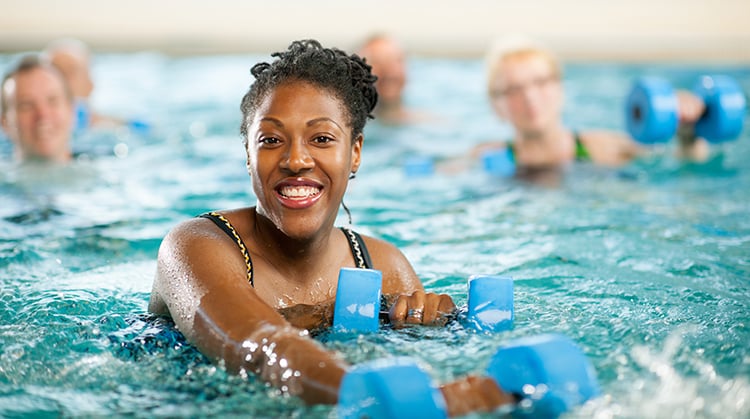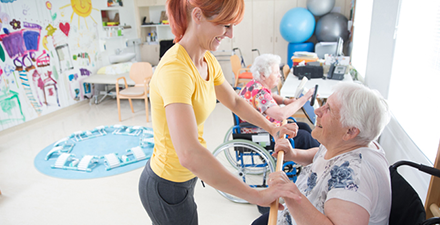
Aquatic exercise refers to exercises performed in water using various water depths. It is a physical activity that offers many benefits. Buoyancy, which is a water property, also benefits the person exercising by supporting a portion of their body weight.
Being immersed in water can allow a person to perform exercises that may be difficult to do on land. The buoyancy of water can make it easier to move and improve your flexibility. Water also provides resistance to movements, which helps to strengthen muscles. In addition, by supporting much of a person’s body weight, buoyancy reduces the load placed on joints. This can allow a person to exercise sooner after an injury or surgery than would be safe or possible on land.
Strengthening and flexibility exercises are important for managing and recovering from many conditions. Regular physical activity can benefit your physical, mental, and social health. It also can help you prevent or improve many chronic conditions, such as heart disease, diabetes, obesity, depression, and weakness associated with cancer treatment.
Pool exercises can improve your:
- Agility (ability to move quickly and easily).
- Balance.
- Cardiovascular fitness.
- Flexibility.
- Strength and endurance.
- Walking.
Many conditions can benefit from and improve with pool exercise. These include, but are not limited to:
- Various types of arthritis and other rheumatoid conditions such as lupus.
- Fibromyalgia.
- Back pain.
- Joint replacements.
- Weakness.
- Neurological conditions (such as stroke, multiple sclerosis, and Parkinson disease).
- Balance problems.
- Joint and muscle pain.
Pool exercises also are helpful for children with developmental disorders such as cerebral palsy, spinal muscular atrophy, and autism. Also, older adults can reduce their risk of falls when exercising in a pool compared with exercising on land.
Preparing for the Pool
Before starting a pool exercise program, check with your physical therapist or primary care provider to ensure the exercises are right for you. Then, follow these tips for the best possible experience:
- Water shoes will help provide traction on the pool floor and protect your toes from being scratched.
- In general, exercise in water that is waist or chest high. If you have a specific condition, ask a physical therapist for the best water level for your condition.
- Choose a water temperature that is best for your condition. Exercising in cooler water may allow a person to exercise more without fatiguing. Exercising in warmer water may be good for reducing pain.
- Use a Styrofoam noodle or floatation belt/vest to keep you afloat in deeper water.
- Slower movements in the water will provide less resistance than faster movements.
- Use webbed water gloves, Styrofoam weights, inflated balls, or kickboards to increase resistance.
- Never push your body through pain during any exercise.
- Although you will not notice it, you still sweat with pool exercises; it is important to drink plenty of water.
10 Excellent Exercises for the Pool
- Water walking or jogging (forward, backward, and sideways). Start by walking forward in chest- or waist-high water. Walk 10-20 steps forward and then the same distance backward. Increase speed to make it more difficult. Also, increase the intensity of your effort by jogging gently in place. Switch between jogging for 30 seconds and walking in place for 30 seconds for five minutes. You can hold a kickboard vertically in the water while walking to increase resistance. Sideways walking: As a progression, try walking sideways by crossing your right foot in front of your left, bringing your left foot back to start, then cross your right foot behind your left foot. Continue with this pattern for 20 steps in one direction, then 20 steps in the other.
- Forward and side lunges. Stand near a pool wall for support, if needed, and take a big lunge step in a forward direction. Do not let the knee in front of you advance past your toes. Return to the starting position and repeat with the other leg. For a side lunge, face the pool wall and take a giant step to the side. Keep your toes facing forward. Repeat on the other side. Try three sets of 10 lunge steps. For variation, do your lunges forward or sideways across the pool instead of staying in place.
- One leg stand/balance. Stand on one leg while raising the other knee to hip level. Place a pool noodle under the raised leg so it forms a “U” with your foot in the center of the U. Hold as long as you can up to 30 seconds, then switch legs. Try one to two sets of five on each leg. If you have trouble with balance, try this exercise while holding onto the side of the pool or without using a noodle.
- Sidestepping. Face the pool wall. While keeping an upright posture, take sideways steps with your body and toes facing the wall. Take 10-20 steps in one direction and then return. Repeat twice in each direction.
- Hip kickers. Stand with the pool wall to one side of your body for support. Move one leg forward with your knee straight, like you are kicking. Return to start. Then move the same leg to the side and return to the start position. Then move that same leg behind you. Lastly, move your leg in a circle (as if drawing a circle on the pool floor). Repeat three sets of 10, then switch the kicking leg.
- Pool planks. Hold the noodle parallel to the pool floor with both hands (shoulder-width apart). Keep your toes on the pool floor as you straighten your elbows and lean forward to submerge the noodle in front of you, so you end up in a plank position. Your body should be straight and diagonal to the pool floor. Hold from 15 to 60 seconds (as long as comfortable). Repeat three to five times.
- Deepwater bicycle. In deeper water, loop one or two noodles around the back of your body and rest your arms on top of the noodle for support. Move your legs as if you are riding a bicycle. Continue for three to five minutes.
- Arm raises. Stand in water deep enough to submerge your shoulders. Using arm paddles or webbed gloves for added resistance, hold your arms at your sides and bend your elbows to 90 degrees. Keeping your elbows bent and your shoulders down, raise your arms outward toward the water surface, then bring them back to your sides. Repeat for three sets of 10. You can perform arm raises while standing on one leg to challenge your balance during exercise.
- Pushups. While standing in the water at arm’s length from the pool edge, place your hands shoulder-width apart on the pool edge. Keeping your feet on the pool floor and your body straight, lower your chest toward the pool edge. Then press your weight through your hands to raise your body back up to the starting position. Repeat for three sets of 10. For more challenge: While standing close to the poolside, place arms shoulder-width apart on the pool edge. Press your weight through your hands to raise your body up and halfway out of the water (keep your elbows slightly bent). Hold for three seconds, then slowly lower your body back into the pool.
- Standing knee lift. Stand with your back against the pool wall and both feet on the floor. Lift one knee like you are marching in place. While your knee is even with your hip, straighten your knee so your leg is parallel to the pool floor. Continue to bend and straighten your knee 10 times, then repeat on the other leg. Complete three sets of 10 on each leg. For more challenge: Try this exercise without standing against the pool wall.
If you have limited mobility or a chronic condition that makes it hard for you to do these pool exercises on your own, a physical therapist can help.
Physical therapists are movement experts who use the best available evidence to design treatment plans for each person’s needs and goals. They improve quality of life through hands-on care, patient education, and prescribed movement. Ask your doctor how physical therapy can help you or contact a physical therapist directly* for an evaluation. To find a physical therapist in your area, visit Find a PT.
*You do not need a referral to see a physical therapist for an evaluation. Some health care plans require a referral from a primary care doctor. Check with your insurance provider to see if you need one before your first visit.


